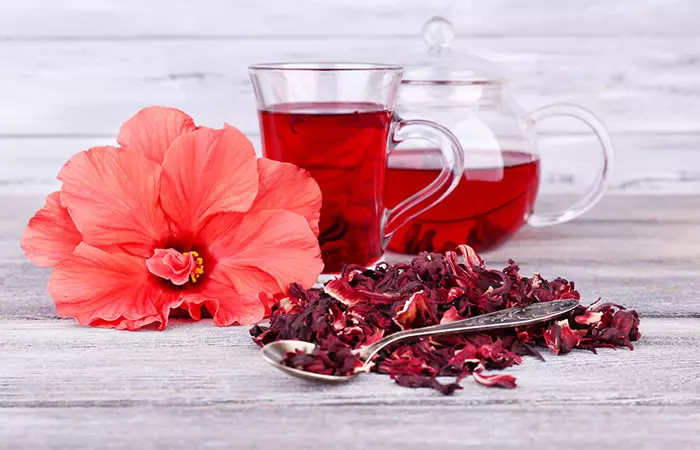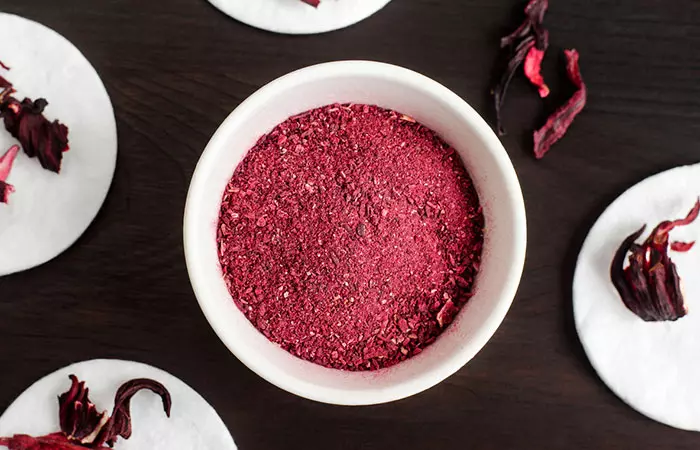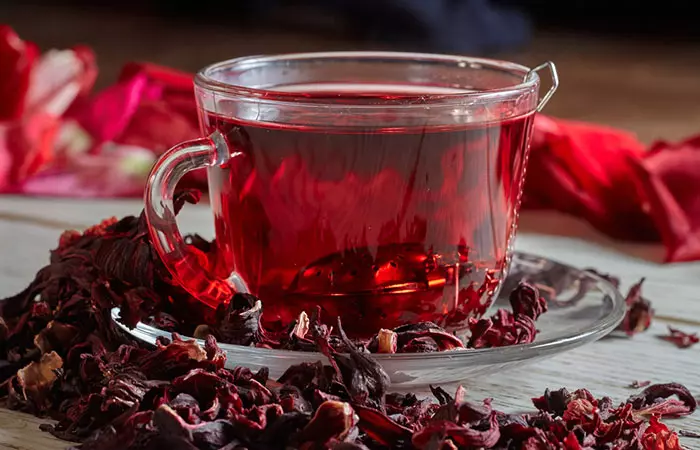If you wish to integrate this beneficial ingredient into your daily skin care routine, we can guide you. This article lists the benefits of hibiscus and how to use it to keep your skin healthy and youthful.
Hibiscus for skincare is a popular natural remedy, due to its anti-aging, moisturizing, and soothing properties that enhance your beauty and improve your complexion. Here are some of the benefits: Who Can Use It? Safe for consumption but some individuals might be allergic to it. How Often? DIY homemade hibiscus masks can be used every day. Hibiscus tea can be consumed daily in moderation. Caution It might not be safe for pregnant or breastfeeding women. It may cause allergic reactions and affect blood sugar levels.
1. Acts As A Natural Antioxidant
Hibiscus extract acts as a natural antioxidant . This plant-based extract can maintain collagen production and decrease melanin synthesis that happens due to overexposure to UVB radiation (3). In simpler words, it can delay the signs of aging otherwise caused due to exposure to UV rays and excess pollution.
2. May Aid In Wound Healing
Hibiscus may enhance the skin’s healing potential by accelerating the wound healing process. It also stimulates skin regeneration and hydration. It achieves this by promoting the spread of keratinocytes (the major cell type of the epidermis) (4).
3. May Help Tighten The Skin
The antioxidant- and vitamin C-rich hibiscus may boost healthy collagen production levels and make the skin firmer. This property can help those with hyperpigmentation. Hibiscus is also rich in a compound called myricetin that may slow down collagen degradation (5). Some believe that hibiscus may be a natural alternative to Botox treatment. You can apply a mixture of hibiscus powder and avocado oil to your skin to restore skin elasticity and reverse the signs of premature aging.
4. May Ease Skin Inflammation
Hibiscus contains antioxidants called anthocyanins that lend the flower its pinkish-red hue. They also are responsible for its anti-inflammatory properties (6). They may help reduce oxidative stress and associated skin inflammation. These are the few important benefits of hibiscus for skin care. However, more research is needed to understand if the flower has any other skin benefits.
How Do You Use Hibiscus For Skin Lightening?
DIY Recipe 1: Hibiscus For Acne
This hibiscus face mask helps treat acne and tones your skin. It also may help cleanse and exfoliate your skin. However, skip the lemon juice if you have sensitive skin. Ingredients
Hibiscus powder – 2 teaspoons Aloe vera gel or yogurt – 1 tablespoon (you may also take ½ a tablespoon of each) Lemon juice – 1 teaspoon
MethodStep 1: Mix the aloe vera gel or yogurt with the hibiscus powder. Step 2: Add a few drops of lemon juice (if you do not have sensitive skin). Step 3: Mix to form a thick paste. Step 4: Apply to your face and neck and leave it on for about 30 minutes. You can apply this face mask every day for a month to reduce acne and rejuvenate your skin from within.
DIY Recipe 2: Hibiscus For Moisturizing Your Skin
Ingredients
Dried hibiscus petal powder made from 20 to 30 petals Olive or almond oil – 2 tablespoons Few pieces of saffron strands Aloe vera gel – 1 tablespoon Muslin cloth
MethodStep 1: Add the olive or almond oil to the dried hibiscus petals Step 2: Grind the mixture. Step 3: Place the mixture in the microwave for about 2 to 3 minutes. Step 4: Transfer the mixture to a piece of muslin cloth and squeeze the oil into a small bowl. Step 5: Add a few strands of saffron and aloe vera gel to the oil and mix well till you get a smooth paste. Your DIY hibiscus moisturizer is ready.
DIY Recipe 3: Hibiscus Water For Your Skin
Hibiscus water can exfoliate your skin, draw out toxins and excess oils, and smoothen skin. Ingredients
Hibiscus flower powder – 1 teaspoon Multani mitti (Fuller’s earth) – 1 teaspoon Rosewater – 1 ½ tablespoons
MethodStep 1: Mix the fuller’s earth, rose water, and hibiscus powder to create a thick paste. Step 2: Apply the paste all over the face. Step 3: Let it sit for about 20 minutes before you wipe it off with a damp cotton ball.
DIY Recipe 4: Hibiscus Scrub For Skin
As mentioned earlier, hibiscus can act as a natural exfoliator. Try this softening and hydrating scrub to remove dead skin cells and prevent acne breakouts. Ingredients
Sugar granules – 1 teaspoon Honey – 1 teaspoon Hibiscus powder – 1 teaspoon
MethodStep 1: Mix the granular sugar, honey, and hibiscus powder. Step 2: Gently apply the scrub to damp skin while you are in the shower. Step 3: Massage in circular motions for about 5 minutes and rinse with cool water.
DIY Recipe 5: Hibiscus Lip Balm
The hibiscus lip balm can remove the dead skin cells and make your lips look plump and pink. Ingredients
Hibiscus flower – 6 to 8 petals Coconut oil – 1 teaspoon
MethodStep 1: Crush the 6 to 8 petals of the hibiscus flower to get a fine powder. Step 2: Add a teaspoon of coconut oil to it. Step 3: Apply the mixture to your lips as and when required.
DIY Recipe 6: Hibiscus Tea
Nothing enriches your mind and body like a cup of tea after a long day. Drinking hibiscus tea benefits skin health from within. Ingredients
Dried hibiscus flowers – ½ a cup Water – 8 cups Honey – ¼ cup Fresh lime juice – 3 tablespoons
MethodStep 1: Add the dried hibiscus flowers and water to a large pot and bring to a boil. Step 2: Once the water starts boiling, switch off the flame and cover the vessel. Note: You can add other herbs of your choice – including basil, lemongrass, lemon zest, mint, etc. Step 3: Let the tea steep for about 15 to 20 minutes. Step 4: Mix in the honey and lime juice until they dissolve completely. Step 5: Strain the tea. Step 6: Consume it warm or chilled. Betty, a YouTuber shared her experience of drinking hibiscus tea for a week. She noticed some potential changes, and said, “So this tea has been so good to my body, not only my face, it has really worked well for my gut and also for my bowel movement, and it has really helped me in losing weight (i).” Including hibiscus in your skin care routine is quite simple. However, anecdotal evidence suggests that it may also cause side effects. Be wary about them before using the flower.
Side Effects Of Hibiscus
Hibiscus tea is considered safe when taken orally up to 720 mL daily for about 6 weeks. Exceeding the prescribed amount may cause stomach upset, gas, and constipation. Do not consume hibiscus tea if you are pregnant or are breastfeeding. Its safety in this regard is not known. Consuming hibiscus may affect your blood sugar levels. Hence, avoid its intake at least two weeks before and after surgery. Hibiscus may also cause skin allergies in some. Conduct a patch test to check for any allergies.
Learn how to make your own hibiscus flower face cream for smooth, pimple-free, glowing skin. Watch the following video to know more! However, consuming an excess amount of hibiscus extract may cause side effects. Always perform a patch test if you are using it on your skin for the first time. Consult a doctor if you have doubts regarding consuming hibiscus. Is hibiscus good for dark circles? According to a study, hibiscus functions as a natural antioxidant capable of maintaining collagen formation and decreasing melanin syntheses. As a result, it can help minimize dark circles, wrinkles, and puffiness. Dab a small quantity onto the fingertips and carefully apply in an outward motion (7). Does hibiscus powder stain skin? Hibiscus powder produces a lovely rose-colored, pigment-rich mask without staining the skin. It will, however, stain your clothes and towels. As a result, wear stain-resistant clothing and use stain-resistant towels. Can hibiscus remove blackheads? A face scrub consisting of hibiscus and other natural exfoliants like lemon juice or orange peel powder can help remove blackheads. Also, based on anecdotal evidence, hibiscus’ astringent nature may help control facial oil secretion and further prevent blackheads from occurring.
Illustration: Hibiscus For Skin: 4 Benefits How To Use And Side Effects












